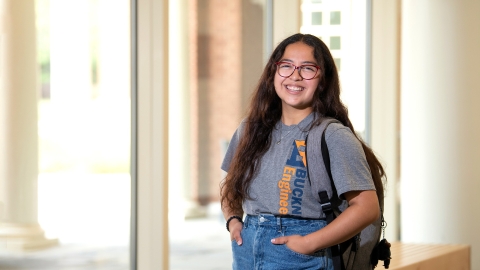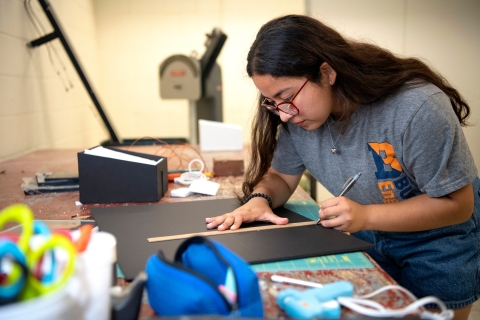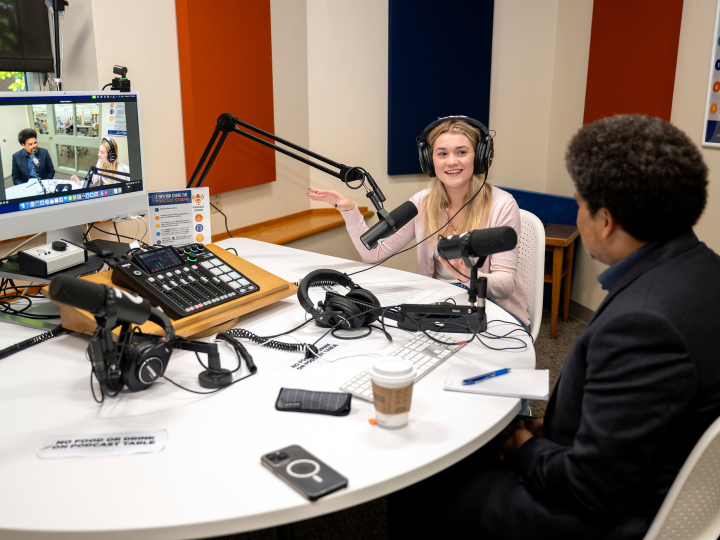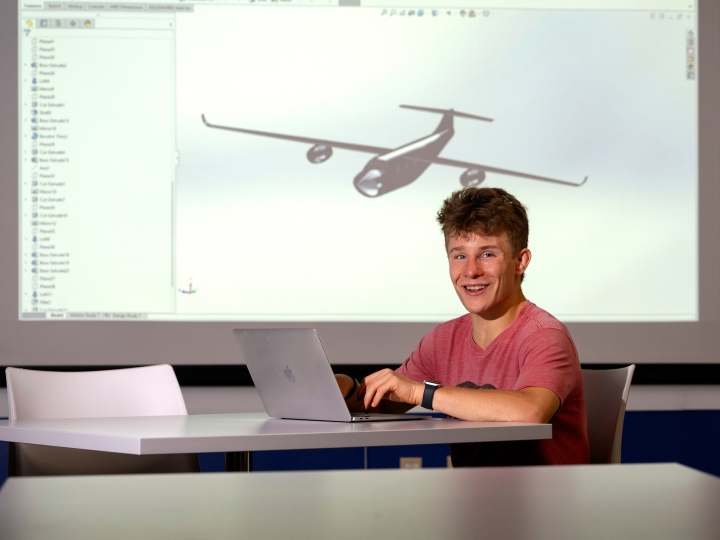
Cindy Cortez ’24, Civil Engineering
August 6, 2021
Cindy Cortez '24 is learning what it takes to make a sustainable building while sharing her findings with high school students. Photo by Emily Paine, Communications
Growing up in Guatemala, with its Mayan archaeological sites, volcanic mountain ranges and serene waterfalls that cascade into turquoise pools, Cindy Cortez '24 learned to love and care about the environment from an early age.
But living in Central America's most populous country, Cortez wasn't exactly overrun with examples of how to protect all that surrounded her. While its status has improved in the years since Cortez's childhood, Guatemala ranks 69th in the U.S. News & World Report rankings of 2021's most sustainable countries. (The U.S. ranks 20th.)
Everything changed when Cortez moved to the 10th-ranked country on that list: the Netherlands, where she attended UWC, a high school for international students.
"There was all this solar power, windmills everywhere, public transportation, electric buses," she says. "There were more bicycles than people."
As Cortez lived in this new place, she began to soak up just what it takes to build a more sustainable community. One major factor: education.
"Sometimes we don't take care of the environment because we don't know how things work," she says.
So even as the civil engineering major takes hands-on courses to advance her understanding of what it takes to make a sustainable building, she's also sharing what she's learning with high school students.

Cindy Cortez uses a heat lamp to examine how changes in a building, such as window placement, affect the temperature inside. Photo by Emily Paine, Communications
Windows of Opportunity
She's also taking her studies beyond class by doing her own research under the guidance of professors. A thousand different factors can contribute to a building's environmental footprint, so Cortez has chosen to focus her research on one key element: windows. She's especially interested in how the size, material and placement of windows affect a building's energy use.
Using a computer program called WUFI, Cortez conducts virtual tests of various window designs in all four seasons — all without having to wait for the calendar to change.
Civil engineers have long believed that south-facing windows are the primary sources of heat gain in the summer, but Cortez has discovered that east- and west-facing windows play an important role, too.
"It's just shocking, because in architecture and design people always focus on the south windows," she says. "You don't consider those other two sides."
When winter arrives and the days get shorter and colder, civil engineers now want to get no-cost heat from those same windows. So Cortez is also studying window shades that are angled to block the high summer sun while still letting in the lower winter sun.
Sharing What She Learns
A sustainably designed building is the byproduct of compromises between the designers and the occupants. The most sustainable building wouldn't have any windows at all, Cortez says, but the quality of life inside would suffer.
That's a point Cortez will ponder with a group of high school students at a camp she's helping organize with Professor Stephen Buonopane, civil & environmental engineering.
Using the same types of hands-on experiences she's had at Bucknell, Cortez will help these high schoolers understand the realities of sustainable building design.

Cindy Cortez creates a model that will allow her to quickly and efficiently test various hypotheses about sustainable buildings. Photo by Emily Paine, Communications
Creating Good
Cortez chose civil engineering because she knows of her field's power to create. But she also knows that power comes with responsibility.
"As civil engineers, we create," she says. "And one of my biggest fears is to destroy. I'd rather create something that will help the environment and nature to flourish."
Cortez suspects that as a civil engineer focused on sustainability, she'll spend part of her time persuading others to put more of their attention on protecting the planet. For some, she'll appeal to their fiscal responsibility, explaining that buildings that use less energy will cost less to operate.
For others, she might need to put up more of a fight to get her message through. That's something she's done all her life — from holding her own on the basketball court despite often being the shortest player in the game to stepping confidently into an industry where men still outnumber women.
"I like fighting. I like showing what we can do," she says. "If people start supporting women and giving them a chance to participate — if we have a voice — we can actually do something."

